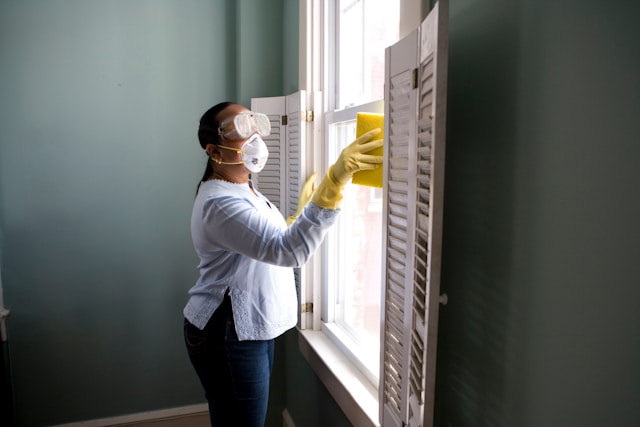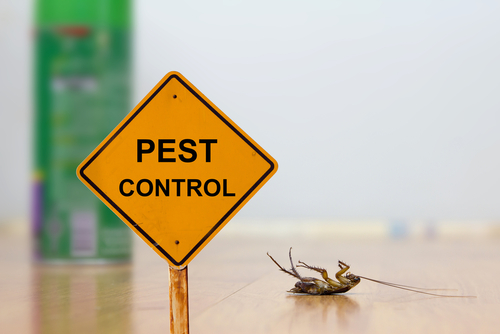What Are Pests?
Pests are organisms, including insects, weeds, fungi, rodents and birds that can cause harm or damage to plants, crops, property, and health. This category includes both plants and animals that can transmit diseases, cause health issues, or damage crops and structures. They can be managed using a variety of methods, including chemical pesticides, biological control, and physical or cultural practices.

Pests can include insects such as cockroaches, mosquitoes, bedbugs, ants, ticks, termites, flies, rodents (like mice or rats), birds, weeds, fungi, and other organisms that cause damage, spread diseases, or are otherwise undesirable. These are labelled as pests when they pose a threat to crops or stored food supplies. It also includes bacteria that are responsible for disease transmission or crop destruction.
Pests can damage crops and livestock, spread diseases to humans and animals, damage property and structures, and cause general annoyance and discomfort.
Pests can cause significant problems, such as:
- Health Risks: Pest control helps to prevent the spread of diseases carried by mosquitoes, ticks, flies, and other pests. Pests can carry and transmit diseases, cause allergies, and contaminate food.
- Property Damage: Pests can damage homes, buildings, crops, and stored goods. Pest control services help to eliminate pests that can infest homes, offices, and other buildings, causing both structural and health problems.
- Economic Impact: Pest infestations can lead to significant financial losses in agriculture, food storage, and other industries. Pest control is crucial for protecting crops from insects, diseases, and weeds. Pests can damage crops, livestock, and other resources, leading to economic losses. In South Africa, pests are a major contributor to food loss, with estimates suggesting that up to 49% of crops are destroyed annually. This leads to the loss of millions of tons of food, posing a significant threat to national food security and placing added pressure on the economy. In severe cases, pest infestations can result in near-total crop failure, ranging from 80% to 100% loss. The financial toll of food loss and waste is overwhelming, with estimates placing the cost at R61.5 billion per year, equivalent to approximately 2.1% of the national GDP. Fruit crops are particularly vulnerable to insect infestation and disease, making them a key area of concern within the agricultural sector.
What is Pest Control?
Pest control refers to the process of eliminating pests or disrupting their reproduction, development or movement to reduce their impact on human activities and the environment. Pest control encompasses a range of strategies aimed at managing and preventing pests from inflicting damage on property and crops or presenting health hazards. Common methods employed in pest control include traps, barriers, and the use of pesticides.
Understanding and Controlling the Health Risks of Pest Control
Pest control plays a critical role in safeguarding public health and preventing property damage. However, it is equally important to understand and manage the health risks associated with pest control, particularly regarding chemical exposure and diseases transmitted by pests. These risks can range from immediate, acute effects like skin irritation or eye stinging to long-term chronic effects, such as certain cancers, respiratory issues, and neurological problems. Additionally, some pests can transmit diseases, further increasing the health risks associated with their presence.
The following factors need to be considered concerning pest control, and why it has to be approached with skill, experience and specialised knowledge:
- Acute Toxicity: Pesticides can be highly toxic, and acute poisoning may occur due to inhalation, ingestion, or skin and eye contact. Symptoms can manifest as headaches, dizziness, nausea, vomiting, stomach cramps, diarrhoea, blurred vision, excessive eye watering, and sweating.
- Chronic Toxicity: Prolonged exposure to pesticides can lead to various chronic health issues, including Parkinson’s disease, asthma, depression, anxiety, ADHD, and certain cancers such as leukaemia and non-Hodgkin’s lymphoma. Some pesticides may disrupt the endocrine system, potentially causing hormonal imbalances that lead to reproductive problems, growth issues, metabolic disorders, and increased risks of diabetes and obesity.
- Pests as Disease Carriers: Pests such as rodents and insects can transmit diseases to humans, such as rabies and leptospirosis. Rabies can be transmitted through bites from infected rodents or bats, and leptospirosis can spread via water contaminated by rodent urine. Salmonella, Lyme disease, and others may also be transmitted, depending on the pest. Mosquitoes carry malaria, dengue, and the Zika virus
- Other Potential Risks: Some individuals may experience allergic reactions to pest control chemicals, whilst direct contact or prolonged exposure to pesticides can irritate the skin and eyes. Inhaling pesticide vapours or dust may lead to respiratory complications, including asthma or difficulty breathing. Pests inevitably contaminate food and food packaging, possibly contributing to foodborne illnesses.
To reduce health risks associated with pest control:
- Use Pesticides Correctly: Always follow label instructions and safety guidelines.
- Wear Personal Protective Equipment (PPE): Gloves, masks, goggles, and protective clothing can reduce direct exposure.
- Hire Professionals: Certified pest control services can ensure safe, effective application.
- Conduct Risk Assessments: Before using any pest control method, identify potential hazards and take preventative measures.
In conclusion, while pest control is vital for maintaining a healthy environment, awareness of the potential health risks linked to pesticide exposure and pest-related diseases is crucial. By understanding these risks and implementing appropriate precautions, pest issues can be managed carefully and safely.
Types of Damage Caused by Pests
Pest infestations in South Africa can result in a wide range of property damage, from serious structural issues such as sagging floors to more superficial problems like chewed furniture and damaged wiring. Termites, in particular, are notorious for their silent, destructive activity, consuming wood from the inside and often going unnoticed until significant and costly repairs are required. Other pests, including cockroaches, carpenter ants, and certain beetles, can also cause considerable damage to both structural elements and household items.
Structural Damage
- Termites
Termites are a major threat in many parts of South Africa. They can cause extensive, hidden damage to wooden structures over time, often compromising the integrity of homes and buildings before being detected. - Carpenter Ants
These ants tunnel through wood to create nests, creating hollow spaces that can weaken the structure. Carpenter ants prefer damp, decaying wood for their nests. They often enter buildings through cracks or openings around windows, doors, or wires. - Wood-Boring Beetles
Various species of beetles bore into timber, causing structural weakening that, if left untreated, can lead to serious damage or even collapse. - Sagging Floors, Doors, and Windows
These are often visible signs of pest-related damage to internal support structures, particularly when wood has been compromised.
Other Types of Damage
- Chewed Furniture and Electrical Wiring
Rodents such as rats and mice can gnaw through furniture, insulation, and wiring, posing serious fire hazards and involving costly repairs. - Damage to Books, Packaging, and Wallpaper
Pests like cockroaches feed on a variety of materials, including book bindings, food packaging, and wallpaper, leading to both aesthetic and functional damage. - Food Contamination
Many pests contaminate food and preparation surfaces, presenting health risks and necessitating extensive cleaning or disposal of affected items. - Agricultural Losses
Pests such as aphids, weevils, locusts and caterpillars can destroy crops and reduce yields. In some cases, invasive species introduced into new environments can quickly become pests due to a lack of natural predators.
Methods of Pest Control
- Physical or Mechanical Methods: These techniques involve the use of physical barriers or devices to prevent, trap, or eliminate pests without the use of chemicals. These control methods include sticky barriers to trap crawling insects, heat treatment for eliminating storage pests, and flooding to manage ground-dwelling pests. Pressure-treated wood offers protection against many wood-damaging fungi and insects, making it an invaluable material in construction and landscaping. Traps are another widely used mechanical method, designed to either kill or capture rodents and other vertebrate pests. In agriculture and urban settings, netting and metal shields are commonly used to protect fruit crops from birds and to prevent birds from roosting on buildings.
Additional methods include electrical light traps, which attract and electrocute flying insects, and air curtains, fly screens or overhead fans installed above doorways create a barrier that deters airborne pests from entering buildings. - Chemical Methods: Pesticides are natural or synthetic chemicals designed to kill or manage pests. They remain the most widely used method of pest control, either eliminating pests directly or disrupting their growth and development. Pesticides are typically classified according to the type of pest they target. For example: insecticides control insect populations, herbicides target unwanted plants or weeds, fungicides prevent or treat fungal growth, rodenticides target rodents such as rats and mice, avicides manage bird populations, and bactericides combat harmful bacteria.
- Biological Control: The biological control of pests uses natural enemies of pests, such as predators, parasites or beneficial microorganisms to control pest populations – for example, introducing parasitic wasps or predatory mites to prey on harmful pests. Another biological method uses bacteria against grubs or insect larvae. However, the development of insect predators to control structural pests has met with little success. Pheromone (own-sex attractants) traps have been used extensively against the fruit fly and gypsy moth. Pheromones are also being used to attract and trap pests that infest stored foods and grains. Biological control can be more environmentally friendly than chemical pesticides.
- Integrated Pest Management (IPM): An alternative approach, known as Integrated Pest Management (IPM), has been widely adopted for managing agricultural pests. IPM involves using a combination of pest control methods to minimise pest problems and environmental impact. This strategy prioritises non-chemical control methods such as crop exclusion, crop rotation, improved sanitation, and biological control to reduce reliance on pesticides. By incorporating these sustainable practices, IPM enhances the effectiveness of pest control programs while minimising environmental impact and promoting long-term agricultural health. Since the 18th century, breeding host plants for pest resistance has been a key strategy in pest control, and planting flowering plants to attract beneficial insects that prey on pests. One of the most extensively researched crops in this regard is wheat. Through dedicated wheat-breeding programs, scientists have developed new varieties that are resistant to rusts – a group of parasitic fungi that attack the leaves and stems of the plant. These advancements have significantly improved crop resilience and productivity, reducing the need for chemical interventions. Crops are often protected from harmful pests through strategic planting techniques that disrupt pest life cycles and reduce infestations. Crop rotation, for instance, helps prevent the buildup of soil-borne fungi and bacteria by alternating plant types, thereby interrupting the conditions pests rely on to thrive. Similarly, open-area planting takes advantage of natural elements such as wind to deter flying insects like flies and beetles, which can cause significant damage to vegetable crops.
- Cultural control: These methods aim to modify the environment in ways that make it less conducive to pests by reducing their access to food, shelter, and breeding sites. Cultural control is also effective against structural pests, which thrive in sheltered spaces like cracks in sidewalks, buildings, and roads, as well as in garbage and overgrown vegetation. By sealing entry points and removing debris, weeds and refuse, these pests can be effectively discouraged from establishing themselves in built environments.
Pest Control Services
Pest control services typically involve a three-step approach to effectively manage infestations and prevent future occurrences, as follows:
- Inspection: Thorough assessment to identify the type of pest, the extent of the infestation, and the source or entry points.
- Treatment: Application of targeted chemical, biological, or mechanical solutions designed to eliminate the identified pests safely and efficiently.
- Prevention: Implementation of long-term preventative measures, such as sealing cracks and gaps, improving sanitation practices, and offering expert advice to reduce the risk of recurrence.
Conclusion
Pest control is essential for safeguarding public health, supporting agriculture, and maintaining homes. By gaining insight into pest behaviour and employing responsible control measures, it is possible to reduce risks and foster healthier, safer living environments. Whether dealing with a few ants in the kitchen or managing a more significant infestation, prompt action, and seeking professional help when necessary, can prevent further damage and provide long-term peace of mind.

